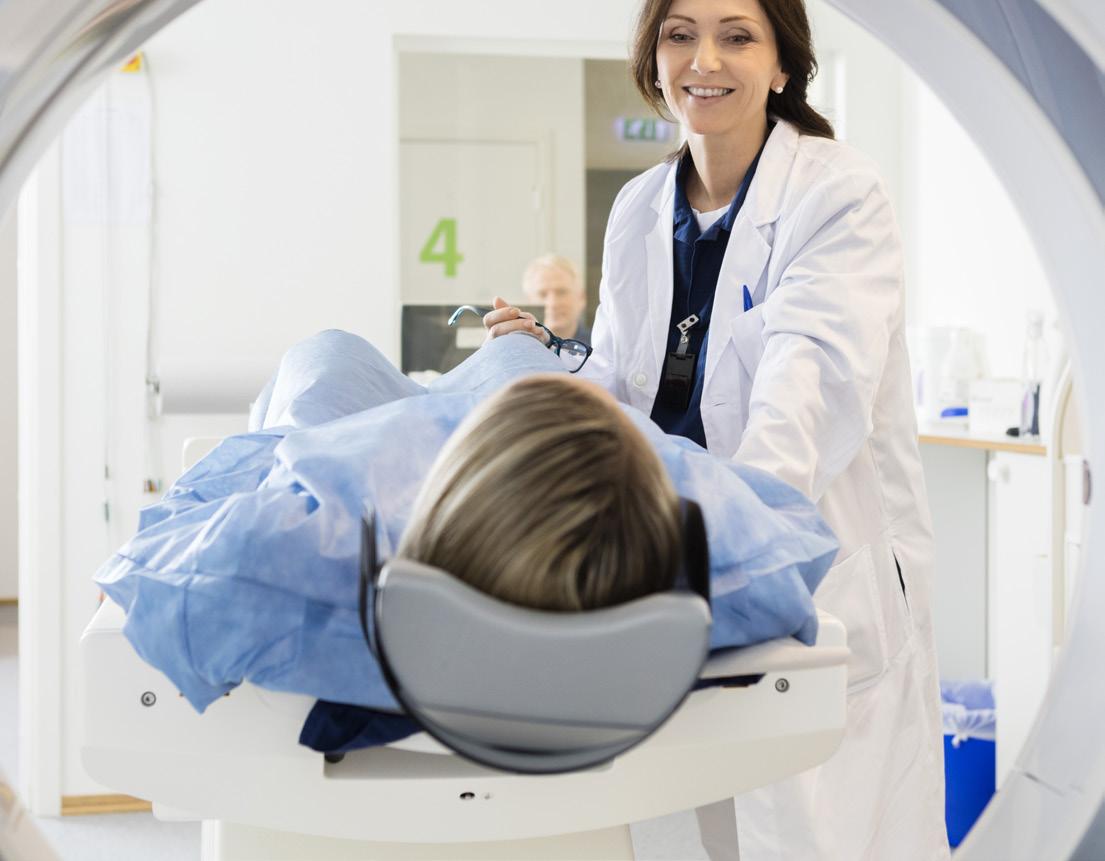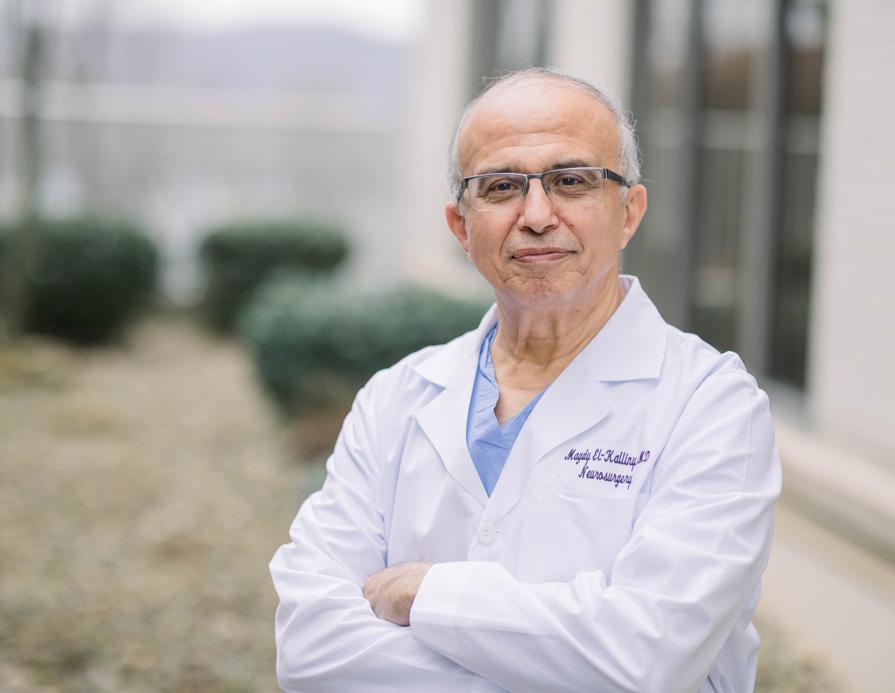
11 minute read
THE STROKE FAMILY CAREGIVER
FEELING TIRED AFTER STROKE
After a stroke, almost all stroke survivors feel tired at some point. Stroke survivors often must work harder to make up for the loss of normal functions (such as being unable to use an arm or hand). But you’ll probably start feeling less tired after a few months. For some people, tiredness may continue for years after a stroke, but they usually find ways to make the most of the energy they have.
Why am I so tired? It’s important to pinpoint what’s causing you to be tired. Then you can take action to manage it. Consult with your healthcare provider to rule out any medical conditions that might cause tiredness or make it worse. You may feel tired after a stroke for four major reasons: • You may have less energy than before because of sleeping poorly, not getting enough exercise, poor nutrition or the side effects of medicine. • You have as much energy as before, but you’re using it differently. Because of the effects of your stroke, things, like dressing, talking or walking, take a lot more effort. Changes in thinking and memory take more concentration. You have to stay “on alert” all the time — and this takes energy. • You also may feel more tired due to emotional changes. Coping with frustration, anxiety, anger and sadness can be draining. Depressed feelings are common after a stroke. Often, loss of energy, interest or enthusiasm occurs along with a depressed mood. • You may feel more tired because of depression. Depression is very common after a stroke. Clinical depression is a treatable illness that happens to many stroke survivors. Symptoms include significant lack of energy, lack of motivation, and problems concentrating or finding enjoyment in anything. Talk to your doctor about an evaluation for clinical depression if tiredness continues.
How can I increase my energy? • Tell your doctor how you feel and make sure you have had an up-to-date physical. Your doctor can evaluate any medical reasons for your tiredness. He or she can also check to see if your fatigue could be a side effect of your medication. • Celebrate your successes. Give yourself credit when you accomplish something. Look at your progress, not at what’s left to be done. • Try naps, or schedule rest periods throughout the day. Rest as long as you need to feel refreshed. • Learn to relax. Sometimes the harder you try to do something, the harder it is to do. You become tense, anxious and frustrated. All this takes more energy. Being relaxed lets you use your energy more efficiently. • Do something you enjoy every day. A positive attitude or experience helps a lot to boost energy levels. • Be social. Go out into the community and interact with friends, family and other people. • Physical activity is important. With permission from your doctor, consider joining a health and wellness program.

THE STROKE FAMILY CAREGIVER

People who provide help for stroke survivors are often called caregivers. Everyone involved in helping a stroke survivor is a caregiver. It can be the spouse, family members or friends. Often one person, spouse, adult child or parent, will provide most of the care.
It’s important that caregivers and stroke survivors strive to be “care partners” in their efforts. It’s often a challenge for both to adjust to their changed roles. The adjustment may be easier if the caregiver and stroke survivor share in decision-making as much as possible and try to share their feelings honestly.
What should a caregiver do? There is no one “job description” that explains what all caregivers do. Each caregiver’s responsibilities vary according to the unique needs of the stroke survivor. Role changes and new skills may need to be learned.
Common responsibilities of caregiving include:
• Providing physical help with personal care and transportation. • Managing financial, legal and business affairs. • Monitoring behavior to ensure safety. • Managing housework and making meals. • Coordinating health care and monitoring or giving medications. • Helping the survivor maintain learned rehab skills and work to improve them. • Providing emotional support for the stroke survivor and family members. • Encouraging the stroke survivor to continue working toward recovery and to be as independent as possible. Is there assistance for caregivers? Many people find caring for another person very rewarding. But there may be times when a stroke survivor’s needs are too much for any one person. Sometimes a caregiver just needs a break.
These community resources may be helpful:
• Adult day care — professional supervision of adults in a social setting during the day. • Adult foster homes — supervised care in approved (licensed) private homes. • Meal programs (Meals on Wheels) — a federally sponsored nutrition program. • Home health aide service — in-home personal care assistance. • Homemaker assistance — supervised, trained personnel who help with household duties. • Respite care — people come into the home for a limited time to give caregivers a break. Some nursing homes also provide short-term respite care.
STROKE DIAGNOSIS

It’s critical to diagnose a stroke in progress because the treatment for stroke depends on the type of stroke, and, in some cases, the location of the injury to the brain. Other conditions with similar symptoms to stroke and transient ischemic attack (TIA) will need to be ruled out to diagnose stroke. Some of these include seizures, fainting, migraine headaches, heart problems or other general medical conditions.
How is a stroke diagnosed? The type of stroke must be determined. Ischemic strokes are caused by a blocked artery in the brain. A ruptured blood vessel causes a hemorrhagic stroke. Treatment for ischemic stroke is different than it is for a hemorrhagic stroke.
Ischemic strokes may be treated using tPA (tissue plasminogen activator). So, it’s important to receive a correct diagnosis before treatment begins. To receive a clot-busting drug treatment such as tPA, a doctor must diagnose your stroke as an ischemic stroke and treat you within 4.5 hours of the onset of symptoms. This treatment usually takes place in the hospital emergency department. If more than 4.5 hours passes, tPA can’t be given.
In the emergency room, your doctor or stroke emergency team may: • Ask you when the symptoms of the stroke started. • Ask you about your medical history. • Conduct a physical and neurological examination. • Have certain lab (blood) tests done. • Do a CT (computed tomography) or MRI (magnetic resonance imaging) brain scan. This determines what kind of stroke a person has had. • Study the results of other diagnostic tests that might be needed.
What are the types of diagnostic tests? Diagnostic tests examine how the brain looks, works and gets its blood supply. Most are safe and painless. These tests fall into two categories: 1) imaging tests and 2) blood flow tests.
IMAGING TESTS: • CT (computed tomography) or CAT scan. It uses radiation to create a picture (like an X-ray) of the brain. It’s usually one of the first tests given to a patient with stroke symptoms. CT test results give valuable information about the cause of stroke and the location and extent of brain injury. • MRI (magnetic resonance imaging). This test uses a large magnetic field to produce an image of the brain. Like the CT scan, it shows the location and extent of brain injury. The image produced by MRI is sharper and more detailed than a CT scan, so it’s often used to diagnose small, deep injuries. • CTA (computed tomographic angiography). In CTA, a special contrast material (dye) is injected into a vein and images are taken of the blood vessels to look for abnormalities such as an aneurysm. • MRA (magnetic resonance angiography). In this test, the blood vessels are imaged through a magnetic resonance scanner to locate a cerebral aneurysm.
BLOOD FLOW TESTS: These tests give information about the condition of arteries in your head and neck that supply blood to your brain. • Cerebral angiography (or cerebral arteriography). Special substances are injected into the blood vessels and an X-ray is taken. This test gives a picture of the blood flow through the vessels. This allows the size and location of blockages to be reviewed. This test is very valuable in diagnosing aneurysms and malformed blood vessels.
STROKE & REHABILITATION
When the immediate crisis of a stroke has passed and you’ve been stabilized medically, it’s time to consider rehabilitation (rehab) therapy.
What is stroke rehabilitation? After a stroke, you may have to change or relearn how you live day to day. Rehab may reverse some of the effects of stroke.
The goals of rehab are to increase independence, improve physical functioning, and help you gain a satisfying quality of life after stroke. Another goal is to help you make lifestyle changes to prevent another stroke.
Who will be a part of my rehabilitation program? Your rehab team may include: • Physiatrist — A medical doctor who specializes in rehab. • Physical therapist — A healthcare provider who specializes in maximizing a stroke survivor’s mobility and independence to improve major motor and sensory impairments, such as walking, balance and coordination. • Occupational therapist — A therapist who focuses on helping stroke survivors rebuild skills in daily living activities such as bathing, toileting and dressing. • Rehabilitation nurse — A nurse who coordinates the medical support needs of stroke survivors throughout rehab. • Speech therapist — A specialist who helps to restore speech and language skills and also treats swallowing disorders. • Recreational therapist — A therapist who helps to modify activities that the survivor enjoyed before the stroke or introduces new ones. • Psychiatrist or psychologist — Specialists who help stroke survivors adjust to the emotional challenges and new circumstances of their lives. • Vocational rehabilitation counselor — A specialist who evaluates work-related abilities of people with disabilities. They can help stroke survivors make the most of their skills to return to work. What will I do in rehabilitation? Rehab programs often focus on: • Activities of daily living such as eating, bathing and dressing. • Mobility skills such as transferring from bed to chair, walking or self-propelling a wheelchair. • Communication skills in speech and language. • Cognitive skills such as memory or problem solving. • Social skills in interacting with other people. • Psychological functioning to improve coping skills and treatment to overcome depression, if needed.



STROKE & APHASIA Aphasia is a language disorder that affects the ability to communicate. It’s most often caused by strokes that occur in areas of the brain that control speech and language.
What are the effects of aphasia? Aphasia does not affect intelligence. Stroke survivors remain mentally alert, even though their speech may be jumbled, fragmented or impossible to understand. Some survivors continue to have: • Trouble speaking, like “getting the words out” • Trouble finding words • Problems understanding what others say • Problems with reading, writing or math • Inability to process long words and infrequently used words
How does it feel to have aphasia? People with aphasia are often frustrated and confused because they can’t speak as well or understand things the way they did before their stroke. They may act differently because of changes in their brain. Imagine looking at the headlines of the morning newspaper and not being able to recognize the words. Or think about trying to say “put the car in the garage” and it comes out “put the train in the house” or “widdle tee car ungsender plissen.” Thousands of alert, intelligent men and women are suddenly plunged into a world of jumbled communication because of aphasia.

Are there different types of aphasia? Yes, there are several forms of aphasia. They include: • Global aphasia — People with this aphasia may be completely unable to speak, name objects, repeat phrases or follow commands. • Broca’s aphasia — The person knows what they want to say, but can’t find the right words (can’t get the words out). • Wernicke’s aphasia — A person with this aphasia can seldom understand what’s being said or control what they’re saying.
How can family and friends help? The stroke survivor and their family members will need the help and support of a doctor, counselor and speech pathologist. It’s a good idea for family and friends to: • Be open about the problem so people can understand. • Always assume that the stroke survivor can hear. Check understanding with yes/no questions. • Set up a daily routine for the person with aphasia that includes rest and time to practice skills. • Use sentences that are short and to the point. • Keep the noise level down and stand where the survivor can see you.
• Remember to treat the stroke survivor as an adult and let him or her share in decision-making. No one likes to be ignored. Include the survivor in your conversation. • Help the stroke survivor cope with feelings of frustration and depression. • Be patient with the person with aphasia. Give them the time they need to try to speak and get their point across to you. This not only respects their dignity, but makes it less stressful for them when communicating.
Certain areas of the brain (usually in the left side of the brain) influence one’s ability to communicate and understand language. When a stroke occurs in one of these areas, it may result in aphasia.




